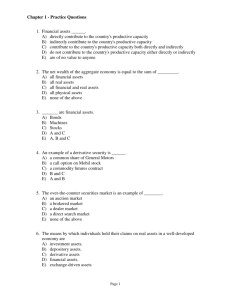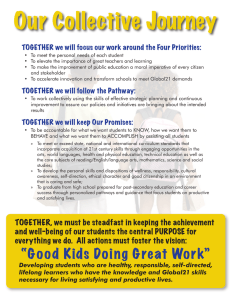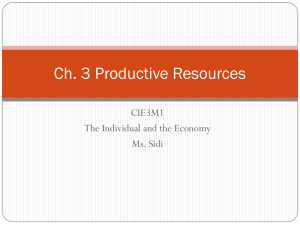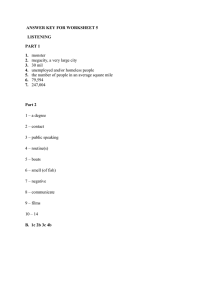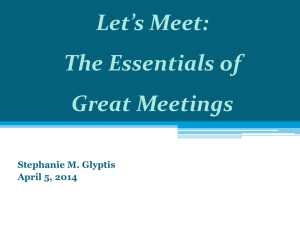Critical Thinking in Education Preparing for the Future
advertisement
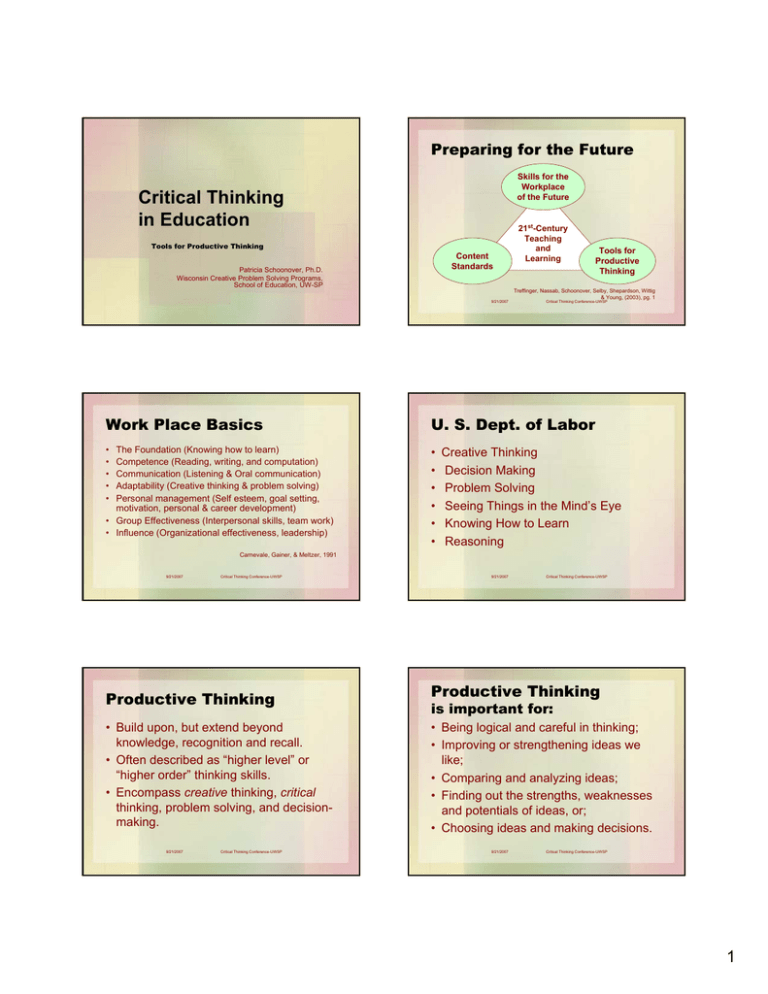
Preparing for the Future Skills for the Workplace of the Future Critical Thinking in Education Tools for Productive Thinking Content Standards Patricia Schoonover, Ph.D. Wisconsin Creative Problem Solving Programs, School of Education, UW-SP 9/21/2007 21st-Century Teaching and Learning Treffinger, Nassab, Schoonover, Selby, Shepardson, Wittig & Young, (2003), pg. 1 Critical Thinking Conference-UWSP Work Place Basics U. S. Dept. of Labor • • • • • • • • • • • The Foundation (Knowing how to learn) Competence (Reading, writing, and computation) Communication (Listening & Oral communication) Adaptability (Creative thinking & problem solving) Personal management (Self esteem, goal setting, motivation, personal & career development) • Group Effectiveness (Interpersonal skills, team work) • Influence (Organizational effectiveness, leadership) Tools for Productive Thinking Creative Thinking Decision Making Problem Solving Seeing Things in the Mind’s Eye Knowing How to Learn Reasoning Carnevale, Gainer, & Meltzer, 1991 9/21/2007 Critical Thinking Conference-UWSP Productive Thinking • Build upon, but extend beyond knowledge, recognition and recall. • Often described as “higher level” or “higher order” thinking skills. • Encompass creative thinking, critical thinking, problem solving, and decisionmaking. 9/21/2007 Critical Thinking Conference-UWSP 9/21/2007 Critical Thinking Conference-UWSP Productive Thinking is important for: • Being logical and careful in thinking; • Improving or strengthening ideas we like; • Comparing and analyzing ideas; • Finding out the strengths, weaknesses and potentials of ideas, or; • Choosing ideas and making decisions. 9/21/2007 Critical Thinking Conference-UWSP 1 Productive Thinking Tools & Process • Proven – used world-wide for more than 50 years & supported by research. • Portable – easy to learn and readily applied. • Powerful – can stimulate important and lasting changes in your life and work. • Practical – can be used with everyday issues as well as long-term challenges and opportunities. • Positive – promotes collaboration and constructive diversity when dealing with complex opportunities, challenges and issues. 9/21/2007 Critical Thinking Conference-UWSP Productive Thinking Tools Help People • • • • Find Clarity Reflect on meaning Find many options Develop innovative solutions • Find issues, opportunities and challenges 9/21/2007 • Evaluate solutions • Refine, categorize ideas • Sort, sift, Analyze • Reflect on impact of ideas and solutions • And much more! Critical Thinking Conference-UWSP Tools for Productive Thinking Tools for Generating Options Tools for Focusing Options Brainstorming and Its Variations. Brainwriting, Brainstorming with Postits™, Other Brainstorming Variations Refining and Developing. Advantages, Limitations (overcome), Uniqueness [AloU]; Pluses, Potentials, Concerns [PPC] Forcing Relationships. Force Fitting, Analogies, Similies, and Metaphors Excursions. Visually Identifying Relationships, Guided Imagery, Imagery Trek Checklisting. Osborn’s Idea Spurring Questions, SCAMPER Analytic. Attribute Listing, Morphological Matrix, Ladder of Abstraction 9/21/2007 Evaluating. Identifying Hits, Evaluation Matrix Organizing. Hot Spots and Highlighting, Musts and Wants, Short/Medium/Long [SML] Analyzing. Generate and Select Criteria, Diagramming to Compare/Contrast Prioritizing. Paired Comparison Analysis [PCA] Critical Thinking Conference-UWSP Creative AND Critical Thinking • We do not separate these concepts; • Some generating tools aid in analytical thinking as do some focusing tools. Some focusing tools help direct us to new paths as we explore and evaluate options. • We refer to this as Creative Productive Thinking. 9/21/2007 Critical Thinking Conference-UWSP Digging Deeper into Ideas Openness and Courage to Explore Ideas Often referred to as convergent or critical thinking. • Refine, develop and strengthen intriguing possibilities. • Set priorities, sorting, arranging, and categorizing ideas. • Constructive approach rather than destructive approach in order to examine ideas. • Focus on how to strengthen or build up ideas by analyzing possibilities in balanced and forward thinking ways. • Going beyond what is given by acquiring and using vast amounts of information. • Gathering, organizing and analyzing data from many sources and domains. • Asking many, varied, and unusual questions. • Challenging their own assumptions and those of others. • Learning from their mistakes. • Turning negatives into positives or obstacles into challenges. Treffinger & Young (2002), pg. 15 9/21/2007 Critical Thinking Conference-UWSP 9/21/2007 Critical Thinking Conference-UWSP 2 Guidelines for Generating Options Include: Guidelines for Focusing Options Include: • Defer judgment – no evaluation, criticism or any judgment (positive or negative) should occur during a generating options session. • Strive for quantity – Quantity builds a pool of options and provides stretch towards more unusual options. • Seek combinations – Putting two diverse options together will help create a new idea. • Freewheel – Allow yourself, and others, to “blue-sky” and to be a bit goofy in order to find unique and obscure paths. • Use Affirmative judgment – Use sentence stems beginning with “How to . . .” or “How might . . .” in order to invite further thinking and development. • Be deliberate – Specific plans for decision-making will be explicit and clear. • Consider novelty – This reminds people to be playful and exploratory in their thinking and to also consider new perspectives and different frames of reference. • Stay on course – The focus or vision you and your group hold for your task will function as a guidepost for staying on course. 9/21/2007 Critical Thinking Conference-UWSP Osborn’s Idea-Spurring Questions 5 W’s and an H: Who, What, When Why, Where, and How? Examples of questions to ask: • Who has more information? Who are the people involved? • What do you already know? What are the key issues? What resources are available? • It is important to consider impressions and all the senses. 9/21/2007 Critical Thinking Conference-UWSP 9/21/2007 Critical Thinking Conference-UWSP Ladder of Abstraction • Why? Why else? • How? How else? This can be applied to any area of the curriculum or any challenge, issue or opportunity. 9/21/2007 Critical Thinking Conference-UWSP Educational Programs: CPS Connection • • • • • The Center for Creative Learning works with all of these programs to help them include Creative Problem Solving process and Productive Thinking Tools into the program and the curriculum. Destination ImagiNation® for students K-College Rising Stars!® for students ages 4-7 Tech Effects® a program with Technical challenges projectOUTREACH® a service-learning program. Future Problem Solving® for students grades 3-12. All of these programs include: • Deliberate Creative Problem Solving process and tools • Connection to the Federal and State Educational Standards • Curriculum activities and lesson plans 9/21/2007 Critical Thinking Conference-UWSP Visit: http://www.creativelearning.com 9/21/2007 Critical Thinking Conference-UWSP 3 Destination ImagiNation® Curriculum Activities in DI DI is about teaching children to: • Work cooperatively on teams • Tap into their individual and group creativity • Find innovative solutions to complex and difficult challenges • Use what they have and improvise the rest. Template for each activity includes: • Area addressed, for example: Science, Technology, or Theater to name a few. • Standard addressed (main standard) • Related Curricular Areas • Goals • Materials Needed • Length of Activity • Thinking Tool • Methods • Assessment Checkpoints • Extension Activities • Notes: Visit: http://www.idodi.org 9/21/2007 Critical Thinking Conference-UWSP 9/21/2007 Critical Thinking Conference-UWSP Charting Your Course Thinking With Standards Resource for Teachers and Team Managers • Compass Points – Curricular activities that teach a tip, tool or technique • Trekking Tools - sessions introduce a creative thinking tool and explain how one might utilize a tool while working on the Challenge. • Pit Stops - These short activities adapt the Instant Challenge concept and connect it to the Team Challenges. Working with the Center for Creative Learning (CCL), a template was developed to help us write curriculum activities using the Thinking Tools and incorporating the Educational Standards. Three books are the result. 9/21/2007 Critical Thinking Conference-UWSP Thinking About Curriculum • Consider the age-grade of class • Consider expectations • Go beyond that by half a year to a year – or more… • Be prepared to be surprised! 9/21/2007 Critical Thinking Conference-UWSP 9/21/2007 Critical Thinking Conference-UWSP Curriculum and Teamwork • Often more fun to work with a group • Do some preliminary work and research before you do this • Consider Scope and Sequence • Can be done online as well as face-to-face 9/21/2007 Critical Thinking Conference-UWSP 4 Benefits of Teamwork McREL • More points of view • Both global and focused viewpoints • Easier to generate more options with a group • Use the tools! (Walk the Talk) • Develop templates and forms that work • Remember, the box is important! (there has to be a box to think out of!) Collection of standards and benchmarks: Mid-continent Research for Education and Learning 2550 S. Parker Road, Ste. 500 Aurora, CO 80014 Phone: 303-337-0990 Fax: 303-337-3005 http://www.mcrel.org/standards/index.asp. 9/21/2007 Critical Thinking Conference-UWSP 9/21/2007 Critical Thinking Conference-UWSP Check out our Resources Wisconsin CPS Programs Office Room 404, College of Professional Studies School of Education, UW-SP Phone: 715-346-4713 or 715-346-3737 Fax: 715-346-4838 http://www.uwsp.edu/education/creative pschoono@uwsp.edu 9/21/2007 Critical Thinking Conference-UWSP 5

